Startup diaries: How Wimp Decaf built with Klaviyo from day one

In June 2024, Wimp Decaf Coffee Co. was a DTC brand with no website—but they had a vision.
Founder Matthew Smith wanted to rebrand decaf as a delicious, chill treat. Not a wimpy, second-fiddle option.
“We’re asking people to give up the idea that decaf is bad coffee for weak people,” Smith says.
He knew decaf’s power firsthand. He used to feel dependent on caffeine. Decaf helped him turn his coffee habit into something sustainable—and he knew it could help other people, too.
He already had 3 decaf coffee roasts, and a Shopify site in the works with offshoot.xyz. It was almost ready to launch.
He just needed to get the word out about Wimp. That meant he and his team needed a marketing automation platform they could afford from day one—and that could grow with them. And as the former founder of Really Good Emails, he knew that it needed powerful email capabilities.
Here’s why Wimp chose Klaviyo, and how they’re using the platform in their first months in business.
Editor’s note: Watch this space for monthly updates on Wimp’s experience.
Behind the scenes: choosing Klaviyo
Smith envisioned email as the pillar of Wimp’s marketing mix: less pricey than paid ads, and less “controlled by the algorithm” — and more personalized — than organic social, he explains.
“Email is relationships, delivered,” says Smith. With the right tech stack, of course.
Email is relationships, delivered.
Why Wimp chose Klaviyo over competitors
Smith and Elijah Richards, head of operations, both knew the email space well—Smith from the design side at Really Good Emails, and Richards as an operator, formerly of In God We Must.
A few things stood out to them about Klaviyo:
- The powerful Shopify integration: It was seamless, reliable, and easy to set up.
- The granular targeting: With Klaviyo, Richards knew he could “really hit the customer journey out of the park,” he says, by targeting customers ultra-specifically—based on which products they browsed and purchased, how often, and how recently.
- The scalability: “I plan on Wimp being a sizeable business,” says Smith. “ I’m not interested in having to start from scratch because our first marketing platform couldn’t keep up with our demands.”
- The familiarity: Richards had used Klaviyo for years, and he knew the platform inside and out.
“I felt that out of the gate, we could do more, faster with Klaviyo than with anybody else,” Smith says.
Why Wimp started off with a paid Klaviyo account
“I want to build a real company,” says Smith. “We’re not in playground mode.”
So from the day they launched their lightweight site, they’ve been on a paid Klaviyo plan. It offers maximum functionality out of the gate, and minimizes blockages.
I want to build a real company. We’re not in playground mode.
“I always tell people to get that base plan up front and pay for it, just to get the analytics and the website tracking dialed in,” Richards explains. “And to remove the Klaviyo branding in the footer for emails, so you can add custom branding—which we’re doing with delight.”
July 2024: Launching everything but the store
On July 5, Wimp launched their lightweight website—with no option to purchase yet, just a waitlist sign-up form and product education—and their Klaviyo account. Here’s how it was all going, one week in.
Performance by the numbers
0
subscribers to start
41
new subscribers on launch day (mostly friends and family)
202
new subscribers in the first week (after just one Tweet on day 7!)
Klaviyo activity by the numbers
1
Klaviyo flow live week of launch
13
lists and segments week of launch
$20
per month for Klaviyo
How Wimp is using Klaviyo so far
They’ve launched an initial, bare-bones welcome flow—what Richards calls a “handshake email”—that’s just one message at sign-up. It includes Wimp’s planned ecomm store launch date (August 16), some more brand story, and a CTA to share Wimp with friends.
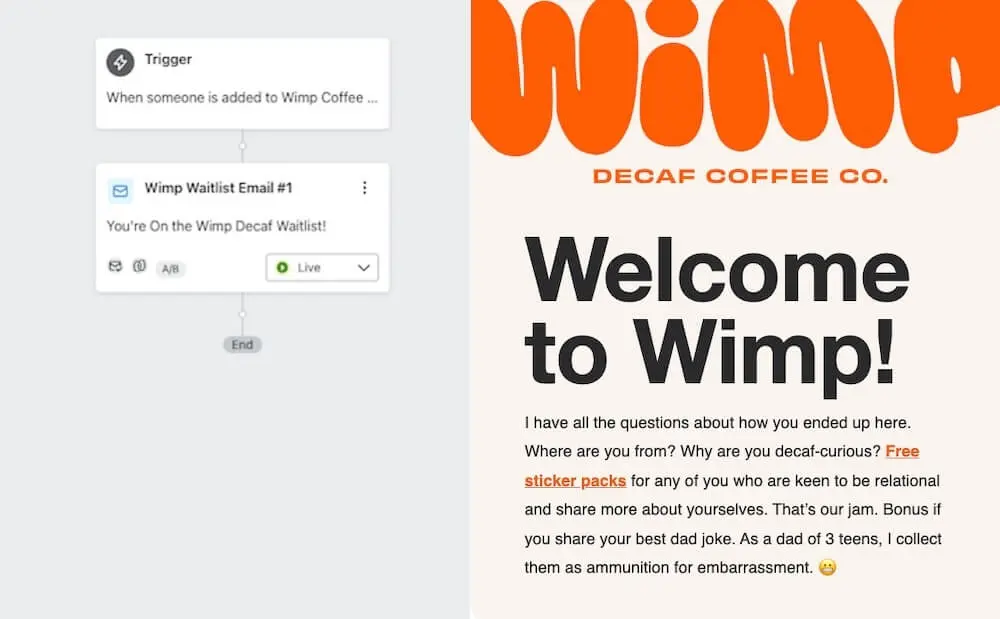
Other things they’ve set up in Klaviyo:
- A primary mailing list, currently populated by a Shopify form embedded in their lightweight site header (additional Klaviyo forms coming soon)
- An array of segments, like 30-, 60-, and 90-day engaged customers, repeat customers, and VIPs
Wimp’s biggest email challenge to date
A few days before the lightweight site launch, Wimp switched their website URL from wimpcoffee.com to wimpdecaf.com. “We’re always going to be only decaf, and we’re really owning that position,” Smith explains.
That meant they needed to authenticate the new domain via DMARC, re-start their warming process, and postpone their launch slightly—“otherwise, we’re basically sending love letters straight to junk mail,” Smith explains.
Next on Wimp’s to-do list
Beyond warming Wimp’s sending domain, Richards wants to move transactional Shopify emails into Klaviyo so they can be Wimp-branded.
In a few weeks, once they understand baseline performance, he and Smith also want to configure store tracking and segmentation for abandonment flows, and start A/B testing elements of their forms and flows.
To complement email, the team is also exploring paid social and paid search media buys.
Moonshot idea of the month
Smith dreams of one day segmenting customers based on whether they prefer “cussy” or “clean” versions of Wimp emails, and messaging each group accordingly.
For now, Wimp is setting up a robust customer preference center, where subscribers can set their preferred email cadence and topics.
“I really want to make sure out of the gate that we’re responding to our audience,” Smith says.
I really want to make sure out of the gate that we’re responding to our audience.
August 2024: Kickstarting ecommerce with no paid ads (yet)
On August 16, Wimp launched their Shopify store with 5 products: 3 roasts, a variety pack, and a gift card. They hadn’t started paid ads yet—but it made an immediate, organic splash.
“The sensation has just been incredible,” says Smith.
The team has learned about a wide variety of reasons customers choose decaf, from doctor’s orders to feeling “decaf curious” (a la “sober curious”).
Here’s what the first week of ecommerce sales looked like by the numbers—and how Wimp used Klaviyo to make it happen.
Performance by the numbers
76
orders on ecommerce launch day
20
first-time purchasers bought coffee subscriptions in first week
$0
spent on paid advertising so far
Klaviyo activity by the numbers
498
email subscribers on ecommerce launch day
58%
of launch day ecommerce revenue attributed to Klaviyo
$20
per month for Klaviyo
How Wimp is using Klaviyo so far
When their store opened its digital doors, they sent a campaign to their full mailing list:
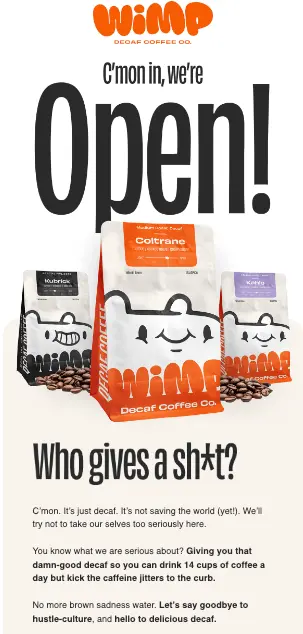
So far, they’ve mainly used Klaviyo to house that mailing list—formerly their waitlist. It’s been a way of capturing and measuring demand before launch.
“Klaviyo meant we had somewhere for people to confidently sign up and get on a waitlist, and then we could send them an email through a flow, and then also be able to track the best time to send emails and start that process of gradual sending,” Richard says. “That was vital.”
Other things Wimp has tried out with Klaviyo:
- Subject line A/B testing: This has helped them optimize campaign performance—and taught them early on that too many emojis in one subject line (4, to be exact) can trigger spam filters. Luckily, they tested an emoji-heavy subject line on a gradual send, which they stopped mid-send—and with just one emoji, they saw more success.
- Exporting Klaviyo template HTML: Smith customized Wimp’s transactional emails, starting from a Klaviyo template base, and Richards exported the HTML into Shopify. It was a quick way to ensure those sends were appropriately branded and “real fun,” Richards says.
Wimp’s biggest email challenge to date
Prioritizing ruthlessly. The 3-person team has tons of exciting, creative ideas for email and beyond—but as they’re currently bootstrapped, none of them can focus on the business full-time yet.
We have to be really diligent about saying no about things that aren’t the most impactful.
So far, email marketing has been a priority — a way to nurture relationships with early adopters, grow LTV, and build community—but they still keep a running list of exciting email ideas for the future that they don’t have bandwidth for.
“One of the things that we have to do regularly is decide, ‘What’s the priority?’” Smith explains. “We have to be really diligent about saying no about things that aren’t the most impactful.”
Next on Wimp’s to-do list
First up: Paid media. Wimp is ready to partner with an agency and see how much incremental demand ads can drive.
Organic response has been great so far—they sold 180+ bags of coffee in less than a week, Richards reports, with lots of customers reaching out to get more involved—which gives Richards confidence.
“There’s lots of money involved in paid media, lots at risk, but the response makes me feel fearless,” he says.
He plans to set up preliminary agency meetings before the end of August, and start testing ads across social platforms in September—using Klaviyo’s integrations with Facebook, Google Ads, TikTok and beyond—so Wimp can build their subscriber list and hone their strategy before BFCM.
Other priority items on the team’s to-do list:
- Abandoned cart flows: Wimp plans to design and launch these ASAP, and optimize their offer—ideally emphasizing witty copy and slick design over discounts.
- Tagging so they can segment by relationship: When the team has email conversations with customers, or resolves a support ticket, they want to start tagging that in Klaviyo. That way, they can segment customers by the level of contact and complication they’ve had with the brand.
Moonshot idea of the month
“My main thing has been: how do we turn every customer we can from a transaction into a deeper relationship?” Smith says.
My main thing has been: how do we turn every customer we can from a transaction into a deeper relationship?
In that spirit, he hopes to one day A/B test two post-purchase messages against each other:
- A highly-designed, survey-style message, where people rate their satisfaction by clicking a button with buttons people could click to rate their satisfaction—where their response would add them to a sentiment-based segment.
- A plain-text, short email from Smith, asking for feedback in a reply—inspired by Sticker Mule’s great plain text emails, which Smith finds really humanize the org.
He’s curious which will drive more engagement, responses, and repeat purchases—and most effectively communicate Wimp’s “decaf vibe” of mental serenity to customers.
Check back in September for Wimp’s next update!
Related content
- How to scale your laid-back brand, according to Marine Layer
- How olive oil brand Graza broke $500K in revenue—without paid ads
- How salons, spas, and fitness studios use Klaviyo

Related content
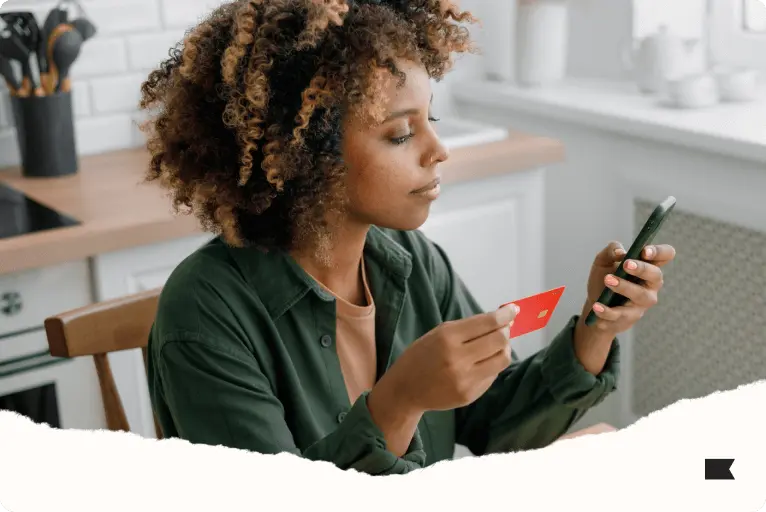
Discover 4 proven ways to reduce cart abandonment and recover lost sales. Learn how to build trust, streamline check-out, and personalize abandoned cart flows to convert more shoppers.
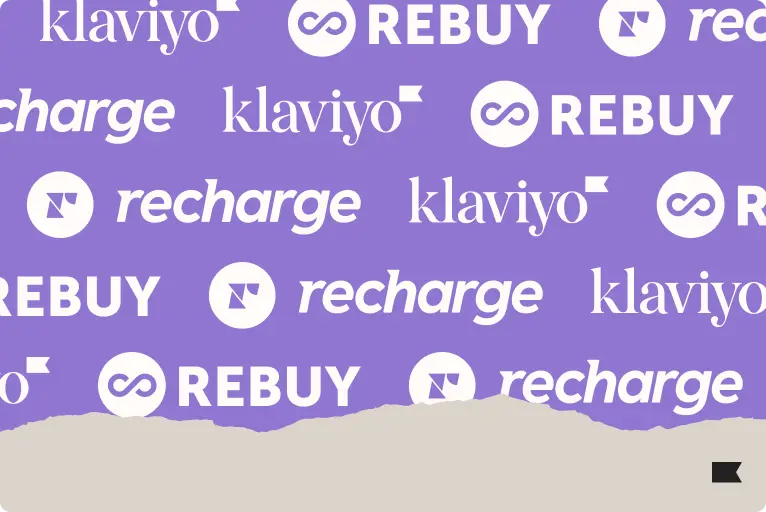
Looking for the best Shopify apps for marketing and customer service? Klaviyo, Rebuy, and Recharge together create a high-performing tech stack that revenue and customer retention.
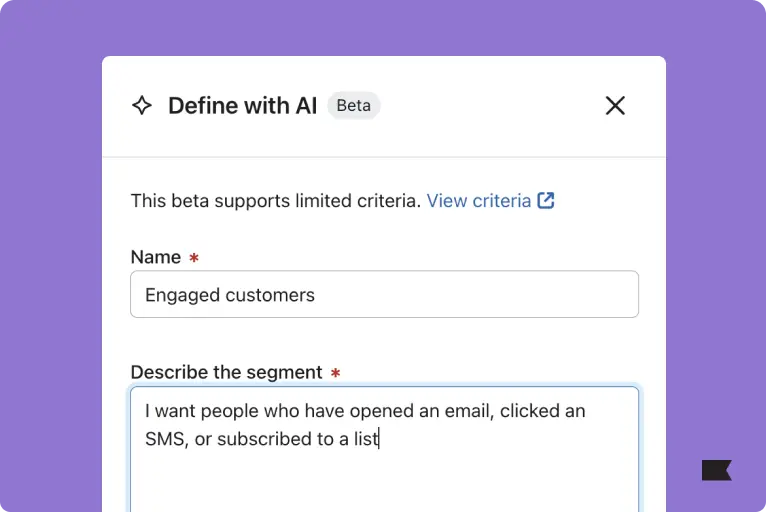
Learn 6 ways brands use AI in marketing automation to target audiences, create content, personalize, predict churn, benchmark, and manage reviews.